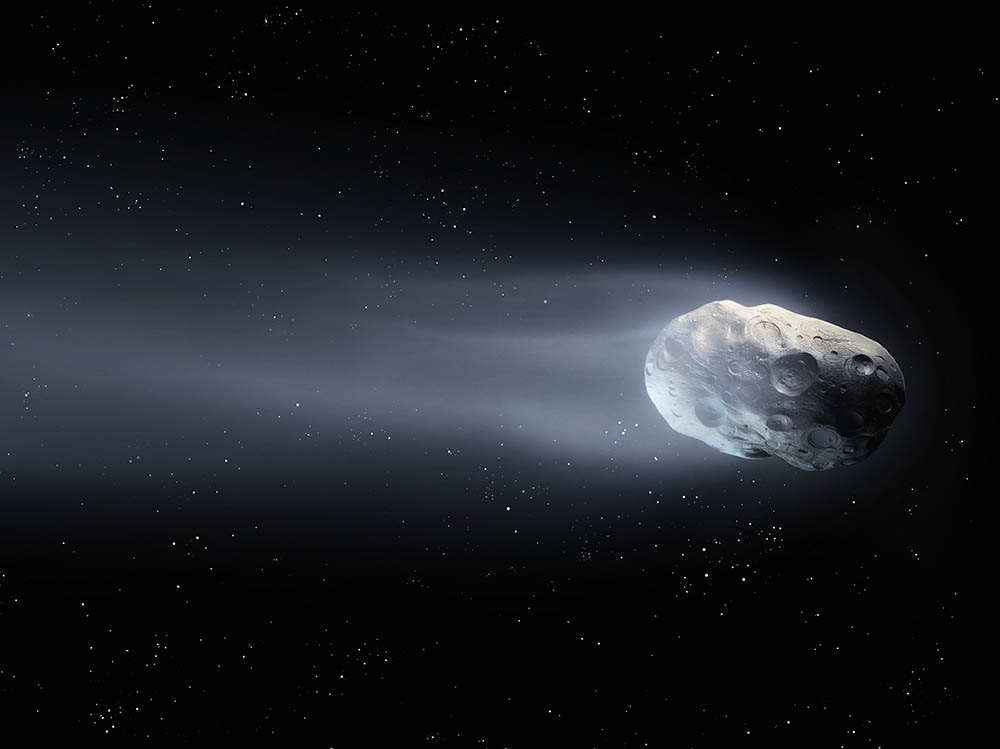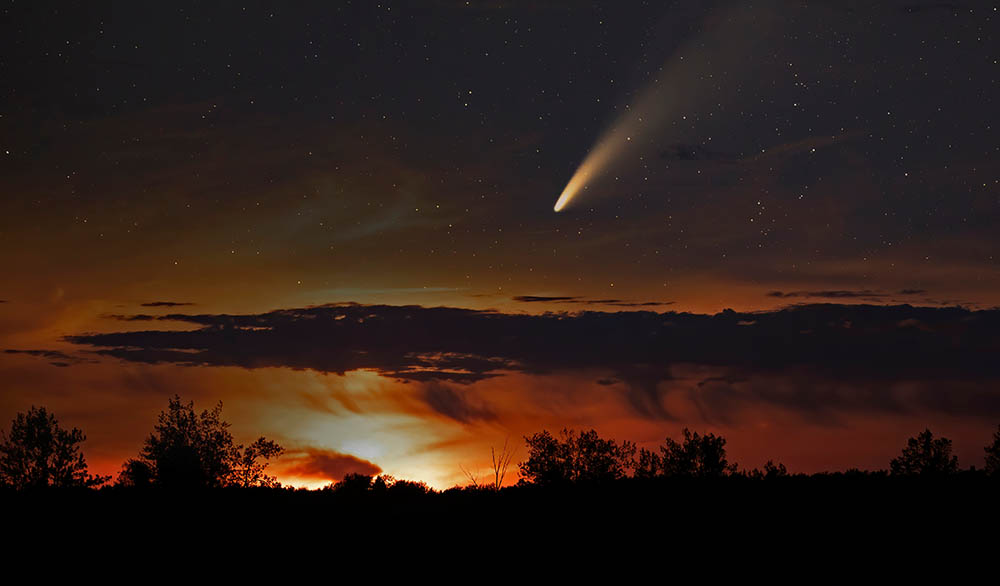How Big Are Comets? What You Need to Know!
Last Updated on

Comets are dusty objects made of dust, rock, frozen gas, and ice. These cosmic snowballs orbit around the Sun like planets but have long, elliptical orbits that planets usually lack. Comets were formed within the solar system.
The comet consists of three parts. The nucleus (center) and the coma (cloud of gas and dust around the nucleus) are present within the comet. Meanwhile, the tail is the stream of dust and gas that comets leave behind. These components give irregular sizes to comets, which are usually hard to determine.
Typically, the smaller comets measure from 2–15 kilometers in diameter¹. However, that is only the size of the nucleus. In addition, the comet’s tail can stretch to 150 million kilometers, making the size of the comets hard to evaluate.
Comets are exciting elements of the solar system. Let’s explore more about these mystical objects and their size.

What Are Comets?
Knowing what comets are and what they consist of helps you better understand their size. The term “comet” comes from the Latin word “comēta,” which means “wearing long hair,” in context with the comet’s tails.
Astronomers took an interest in this dusty snowballs¹ mainly because of their appearance. They have a long tail behind them that looks like a light beam when they travel or orbit around the Sun. This makes them spill-binding to watch.
Comets are usually a few kilometers in diameter, depending on how long their tails stretch. These tails are formed when comets typically go near the Sun. As a result, the comet’s ice and gas composition interacts with the Sun’s light, creating a luminous atmosphere around them.
A few specks of dust, ice, and gas particles of the comets vaporize and move away, forming a tail behind them. When comets are not near the Sun, detecting their tails is almost impossible since these snowballs can’t reflect much of the Sun’s light.

How Many Comets Are There?
About 6,340 comets have been discovered and classified in proper data form. However, astronomers are finding new comets every day, so the figure is supposed to increase considerably in the upcoming years.
What Does a Comet Constitute?
Comets consist of three main parts. All these components contribute to the size of these dusty snowballs. So, let’s learn about them in detail:
- Nucleus: The center, solid part of the comet is the nucleus. It consists of ice and rocks.
- Coma: The coma is a thin atmospheric layer surrounding the nucleus. The gases released by the core form the coma. Coma may seem slightly bigger than the nucleus, but it can be as long as thousands of kilometers.
- Tail: The tail is the visible yet exciting part of the comet. It is the trail of gas and dust that follows the comet from behind when it travels to the Sun. As mentioned above, the tail forms when the ice and dust interact with the Sun’s light. The comet’s tail is always from the Sun.

How Are Comets Formed?
Comets came into being when the solar system formed. Like every other solar system component, comets result from the collision of smaller objects.
Comets are usually present in the Oort Cloud or the Kuiper Belt of the Solar System. This region already consists of trillions of small metallic and icy objects. When these tiny elements collide with each other, they form bigger rocks.
Over time, one of these collision impacts turns out to be strong enough to send one rocky object away from its original orbit, directly in the Sun’s territory. That’s how these snowballs were formed.
How Big Are Comets?
There is no standard size for comets. Instead, these objects have irregular shapes, which differentiate them from planets that are usually circular or spherical. So, it’s pretty tricky to tell how big a comet can be.
Another issue is that small comets are too minute for astronomers to detect. So, whatever information we have right now about comets’ size is only based on what is known, completely ignoring what’s still undiscovered.
Generally, comets measure between 2–25 kilometers in diameter, approximately 1.8–9.3 miles. However, this measurement is only for the comet’s core or nucleus.
The tail itself can get quite long, about 150 million kilometers or 93 million miles. Some comets have shorter tails, while others have relatively longer ones.
Therefore, the size of comets usually differs and primarily depends on the length of their tails. The comet’s tail can extend as far as the distance between the Sun and Earth. This distance is called 1 Astronomical unit (AU).
It’s believed that a comet’s size can be smaller than Manhattan or as big as a football stadium, including the parking lot.

The Largest Comets Ever Seen
In 2021, NASA’s astronomers Pedro Bernardinelli and Gary Bernstein discovered a comet about to hit the Earth in about 10 years. It was named “Bernardinelli-Bernstein”¹ after the two astronomers.
Nasa’s Hubble telescope estimated that the Bernardinelli-Bernstein comet would have a mass of about 500 trillion tons. This makes the comet larger than Rhode Island. The length of this comet was recorded to be 85 miles¹, which can be larger in reality. It was supposed to be bigger than a typical comet that measures only 6 miles wide. It is coming toward the Earth at 22,000 miles per hour and is now present at a distance of fewer than 2 billion miles from the Sun.
Due to its size, scientists confused it with Pluto when it was first identified in June 2021. Bernardinelli-Bernstein was traveling through the Oort cloud, an icy layer in space that is 29 AU away. This comet will take almost a decade to come close to Earth after traveling a distance of 11 AU from the Sun.
Moreover, the comet’s orbit is believed to be so long that it last passed Earth when humans didn’t even exist. It came near the Sun about 3.5 million years ago, which was still 18 AU away. The good thing is that Bernardinelli-Bernstein will not impact our planet whenever it passes through. So, if you’re an astronomy lover, you can set up your telescope in your backyard and witness a mesmerizing meteor shower. Of course, that’s almost 10 years away from 2022.

Different Types of Comets
Since comets are different from one another, scientists struggled quite a lot in classifying them. That is why you may come across several types of comets, making things confusing for you.
In general, you need to know about the four main types of comets:
- Periodic Comets: These comets are short-period comets, having an orbital period of fewer than two centuries. Most periodic comets are usually present in the Kuiper belt.
- Non-Periodic Comets: Also known as long-period comets, non-periodic comets have an orbital period of more than two centuries. These comets are assumed to be in the Oort Cloud.
- Hyperbolic Comets: These comets don’t have particular types of orbits. Many of these comets only revolve around the Sun once in their lifetime and are then pushed outside the solar system. Many astronomers also believe that most hyperbolic comets come from other systems.
- Lost Comets: As evident from their name, these comets are “lost” for unknown reasons even after their discovery. So, their fate is also unidentified.

Final Thoughts
Comets are dusty snowballs made of gasses, rocks, and water. Like every other element of the solar system, they orbit the Sun. While these objects are interesting because of their tail stream, many space lovers and astronomers are confused about their exact size.
Comets usually have irregular shapes with different tail lengths. Typically, the smaller comets have a diameter of between 2–15 kilometers, but that is only the size of the nucleus. The comet’s tail can be as long as 150 million kilometers.
Also, different types of comets have varying compositions and tail lengths, making it impossible to know how big comets actually are.
Featured Image Credit: Nazarii Neshcherenskyi, Shutterstock
About the Author Jeff Weishaupt
Jeff is a tech professional by day, writer, and amateur photographer by night. He's had the privilege of leading software teams for startups to the Fortune 100 over the past two decades. He currently works in the data privacy space. Jeff's amateur photography interests started in 2008 when he got his first DSLR camera, the Canon Rebel. Since then, he's taken tens of thousands of photos. His favorite handheld camera these days is his Google Pixel 6 XL. He loves taking photos of nature and his kids. In 2016, he bought his first drone, the Mavic Pro. Taking photos from the air is an amazing perspective, and he loves to take his drone while traveling.
Related Articles:
Can You Use Binoculars to Look At Stars? How to Choose the Right Pair
15 Crucial Facts About Ultraviolet Rays & the Sun
What Constellation Is Spica In? The Interesting Answer!
10 Interesting Leo Constellation Facts, Myths, and FAQs
15 Interesting Pegasus Constellation Facts, Myths, and FAQs
6 Interesting Sagittarius Constellation Facts, Myths, and FAQs in 2024!
What Are Constellations? Where Did They Come From?
8 Interesting Libra Constellation Facts, Myths, and FAQs
